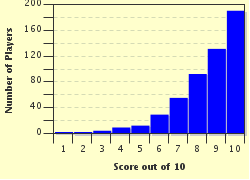Quiz Answer Key and Fun Facts
1. All compounds of this transition metal are considered toxic, but its name was selected because it forms compounds with a range of colors, including lilac, green, blue and yellow. Which element was named for the Germanic goddess of beauty, Vanadis?
2. The toxicity of this element is well known, but when I was a child we still played with it in science classes. What element, also known as quicksilver, is the only metallic element that is liquid at room temperature and pressure?
3. This 'heavy metal' is actually a metalloid, meaning that its properties are transitional between those of a metal and those of a non-metal. Compounds of which of these elements were used in Victorian England to help women whiten their complexions?
4. Compounds of this element, whose name comes from the German word for goblins, have long been used as blue pigments for paints and glass. Mostly produced as a by-product of copper and nickel mining, what is this element?
5. Most people are aware that a deficiency of this element can cause serious health issues as it leads to a shortage of hemoglobin in the blood, a condition referred to as anemia. However, an excessive intake of this element can lead to damage of the heart, liver and other organs. Which element is being described here?
6. Agatha Christie used this heavy metal as a poison in her novel "The Pale Horse" - the clue to the method of murder arising from the fact that the victims suffered hair loss. The toxicity of the element and its compounds has led to its use as a poison in baits for rats and ants, although this is less common now than it used to be. Which element, for which Prussian blue is an antidote, has the chemical symbol Tl?
7. Its use in NiCad batteries makes this element very useful, but it does have a toxicity similar to that of mercury and zinc, both of which have many similar chemical properties to this element, which means its use is declining as suitable substitutes are found. Originally discovered as an impurity in zinc carbonate, which element was named after the founder of the Greek city of Thebes?
8. The most common use of this element (more than half of the world-wide production is earmarked for this use) is in car batteries. You would really hate to see this element disappear, even if its compounds are toxic! Many of its compounds are very colorful, so it has been used in paints, but its use in household paints has been dramatically decreased over the past half century. What element gets its chemical symbol from its Latin name, plumbum?
9. Which metal, probably most familiar from its use as a nuclear fuel and in nuclear weapons, was named for what was then considered the furthest planet from the sun when it was first produced at the Berkeley, CA cyclotron in 1940?
10. Small amounts of this heavy metal are essential for healthy body functioning, but too much of it can lead to serious problems in the respiratory and nervous systems. One of its more familiar compounds is commonly called Condy's crystals, a strong oxidizing agent which dissolves to form a purple solution, and is used as a treatment for fungal infections. What is the chemical name for Condy's crystals?
Source: Author
looney_tunes
This quiz was reviewed by FunTrivia editor
gtho4 before going online.
Any errors found in FunTrivia content are routinely corrected through our feedback system.

